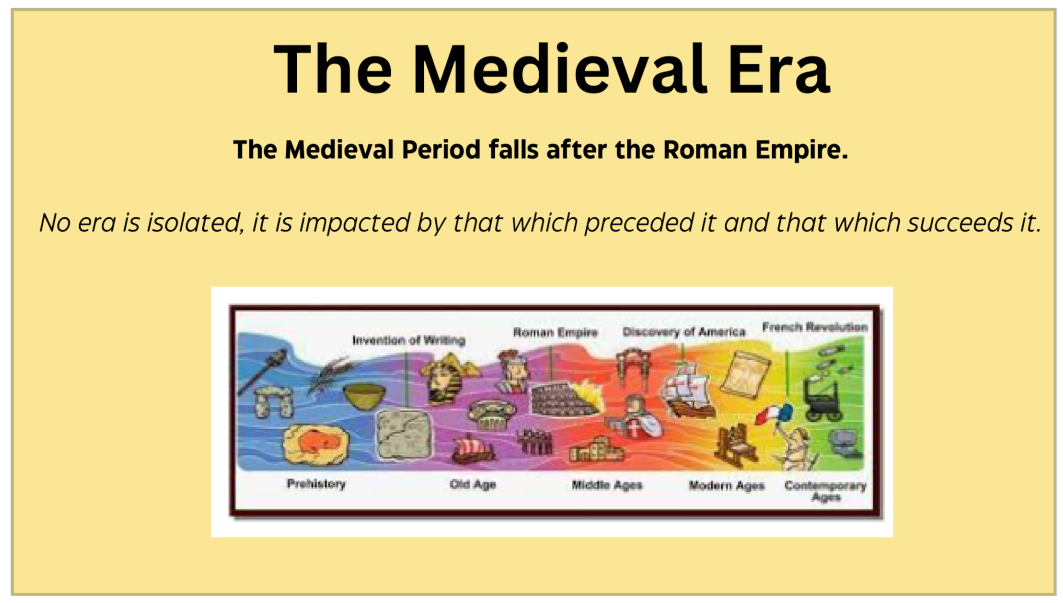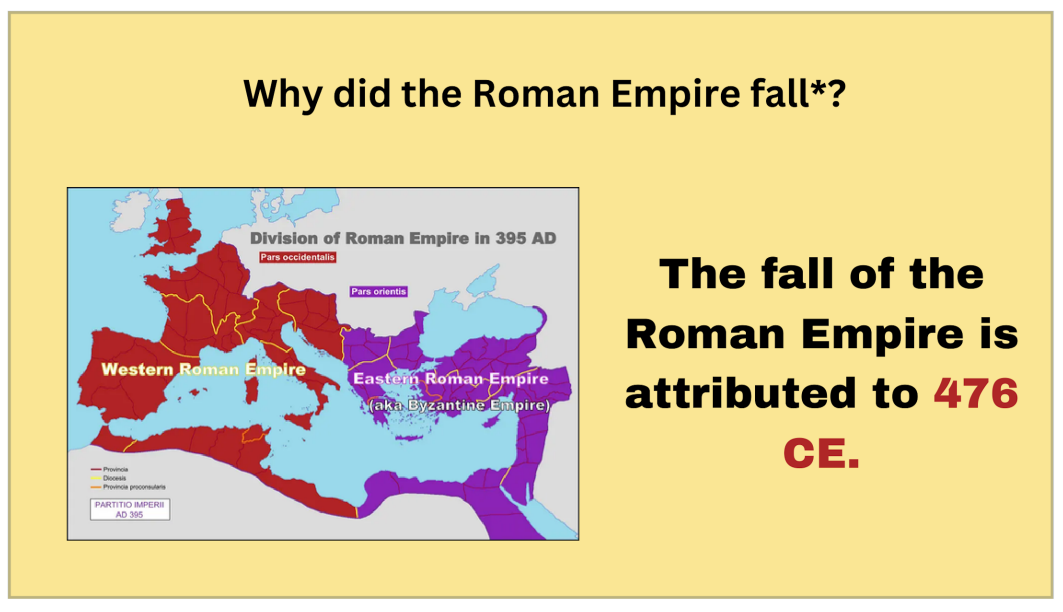Lesson 1 Remixed Lesson Plan
Learning Intention:
To understand how the fall of the Western Roman Empire resulted in the Medieval World.
Success Criteria:
I can explain what we mean by the ‘Fall of the Roman Empire’ and the role barbarians played.
I can explain what a barbarian is and why the term is problematic.
Motivate: Students watch the following video to connect with prior knowledge of Ancient Rome.
Connection Questions: Who is depicted in this video? What civilisation are they from? How did you know (what information did you notice that helped you identify this civilisation)?
Add: Go through the presentation (below) that explores the fall of the Western Roman Empire and the concept of the Barbarian. Students note-take accordingly. As you are going through the presentation follow the script to go with the multimedia content.
Extension: Students also have the choice to watch the additional instructional video (below) exploring three key ideas that they should be aware of for this unit of work. Students should note take these three key ideas in their workbooks if they take this option. These presentations were created with Mayer’s Principles in mind. You can review the suggested teacher checklist here for your own use when creating presentations using this theory.
Practice: Students watch the interactive video (below) and complete the activities. This video expands on the ideas from the first presentation and encourages students to apply their new knowledge in different ways. Then, students should be prompted to complete the drag and drop timeline exercise using the information from the video summarising the key events they explored.
Success: Students complete a short Quiz exploring some of the content from the PPT. Review with students the LI/SC and rank on a scale of understanding (1-5).
Lesson 1 Remixed Content: Synchronous Presentation
The following are example slides of synchronous presentation (Lesson 1) that follow Mayer’s Principles of Multimedia. These slides have been reviewed using the Mayer’s Principles Checklist created for a teacher audience (embedded in the lesson sequence remix).
Accompanying speech with synchronous presentation:
*Note only slides with speech components are listed below. That is, the speech is in addition to the multimedia component. As you can see some of the slides are missing elements of speech (slides 1, 5 & 8) though I understand there may be some redundancy by reading out ‘word for word’ (particularly slide 8) careful consideration was made when deciding on this element.

Slide 2
"When we think of the Roman Empire we are imagining it at its height. This map shows how far reaching the Roman Empire was in 117 CE."

Slide 3
"We are studying the Medieval Era which started after the Western Roman Empire fell. Although such divisions in history are artificial they are helpful as they show broad patterns of change and continuity. This lesson will examine how the early Medieval period was influenced by the Roman empire and how it influenced the end of the Roman Empire. By the end of this lesson you will be able to identify what historians argue distinguishes the early Medieval period from that of Roman times. As our focus for this unit is on the early Medieval era it is important that you understand the wider socio-political context of Europe as much of what we analyse in this unit stems from a strong understanding of this context."

Slide 4
"When we talk about the 'fall of the Roman Empire' we are actually talking about the fall of the Western Roman Empire. This is why the image has a *. This is the western part of the Empire that is colored in red on this map. The eastern Roman Empire continued into the Medieval Era and was called the Byzantine Empire. The key date people use when talking about the fall of the Roman Empire is 476 CE. This is when the last Roman emperor of the west, Romulus Augustulus was deposed by a Roman Solider named Odoacer. The Roman Empire had been slowly degrading in power due to a variety of reasons not just because of Odoacer's actions."

Slide 6
"You may have even heard of someone being called a barbarian. Or perhaps someone's actions were seen as 'barbaric'. This term has negative connotations. However this is not what it originally meant.

Slide 7
"The Romans had to distinguish the many groups of people that they began to incorporate into their Empire. The term they used to describe 'outsiders' was 'barbarian' which in this context means 'other'."

Slide 9
"Roger Collins a historian that explores this period of time notes..."

Slide 10
"This is backed by another historian that studies this time who argues..."

Slide 11
"In other words the barbarians loved the Roman Empire. They saw the benefits of living in this Empire. They didn't want to destroy it. But they did want to continue elements of their culture such as their language, their dress, their religions and traditions all of these form a crucial part of their identity that they didn't want to stop. Instead the barbarians chose what worked for them in Roman Culture and ignored that which didn't. They continued to use Roman tools, infrastructure, ideas even after the Western Roman Empire had fallen."
Lesson 1 Remixed Content: Instructional Video
The following is an example of extension work or optional work for students. The final three slides of the original lesson have been converted into an instructional video format.
The following instructional video was made with clipchamp. The visual presentation was created on Canva, whilst the integration of an audio tack was completed on clipchamp. Ideally, all of this would have been created in the one platform however I didn’t realise until after I’d created the video using the free version of clipchamp already on my computer that Canva has this option as well. Many other programs could be used in its stead, for the update I will likely try Canva as a platform for video creation.
An interesting side note…how I used ChatGPT4.0 to help me with the code of embedding the above video outside of the parametres created by clipchamp (the embedded video was far too small):
Lesson 1 Remixed Content: Timeline Activity
The following interactive timeline activity was created using H5P. It uses a ‘drag and drop’ system. Students receive the following instructions:
1. Place the 8 dates in chronological order on this timeline.
2. Then, place the corresponding events with the date.
3. Make sure you consider your placement carefully, you will lose ‘points’ to this game if you have any incorrect answers.
Good luck!



